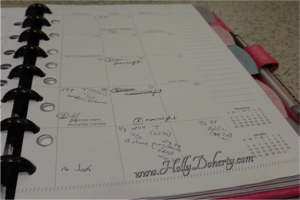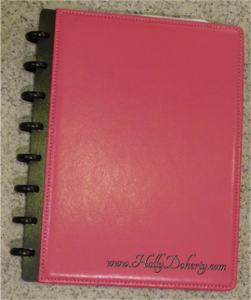Forget appointments? Lose information? Feel scattered? Here’s my secret weapon for keeping everything under control. Well, mostly 🙂
Welcome to Day 3 of the 31 Days of Simplicity series!
One Day 1 we talked about why we need to simplify. One Day 2 I gave you my definition of Simplicity, and how it’s different from other explanations that may have discouraged you from even trying to simplify your life. Today we’re going to dive right in and start talking about easy, practical ideas to simplify your life.
The #1 tool I use to simplify my life is my all-in-one, customizable planner, aka “My Brain.” Seriously. If it’s not written down, it doesn’t happen. In my world, two young kids = very few spare brain cells for remembering things. Can anyone relate?
For me, it’s important to have everything at my fingertips. I know some people use their phone to keep track of appointments and such, but I’m a visual person. I like to be able to see things at a glance, and I can’t stand tapping each individual day on my phone calender to see what’s planned for the coming week or month. So I use a paper planner. The 5 1/2″ x 8 1/2″ size works great for me, because I can tuck it into my purse and take it with me anywhere.
It’s also essential to me that my planner is loose leaf, not spiral bound. Why? Because you can’t customize spiral bound. You get what you get; you can’t add anything. For me, a key to Simplicity is having everything in one place. So I’ve customized my planner with erasable dividers for different sections.  Here’s how I use my planner:
Here’s how I use my planner:
- 2-Page Per Month Calendar Pages. I write my appointments here. My daughter’s swim class, my MOPS meetings, etc. To keep my planner as thin as possible, I have only 3-4 months of Calendar pages in my planner at any time.
- Daily Pages. This is where I keep my To-Do list for the day. (More on that in Day 4.) Also, any details about my appointments go here (address, key people, and so forth). Honestly, the spaces for each day are so small, I don’t write too much here. I tend to use my Notes section more. I keep the current month’s daily pages in my planner, then toss them at the end of the month.
- Projects Tab. I always have about a bajillion projects going on at one time. To help me keep track of everything, I have a master list of every project, then each active project has its own page for notes, status, and next steps. For this section, I use write-on tab dividers (because the paper labels tend to fall out of the insertable kind) and fill each of the following sections with lined refill pages.
- Notes Tab. This section is for random notes that I take throughout the day – details from phone calls, brainstorming ideas, or anything I need to jot down and remember briefly. This is kind of my overflow section for notes that are too big to go in the daily page, or things that are constantly changing. (When I’m tweaking my website design, for example, I note the original specs here in case I don’t like the changes and want to revert back to a previous version). I generally toss each page when I’m done with it. Or, in the case of brainstorming ideas, I’ll keep it in my planner until I’m finished mulling it over, then I save my notes in a more permanent place, like my computer.
- Reference Tab. This section is for more random reference-type info – my family’s clothing and shoe sizes, a list of squirreled-away birthday and Christmas presents (I did mention I’m a geek at heart.) But seriously, this list keeps me from over-spending (usually) because I can see at a glance just how much
crapstuff they’re already getting. I use lined refill pages here too.
 My planner is an ARC planner from Staples. It’s a disc-bound planner. I decided on this particular one because it was inexpensive, and thinner than true loose-leaf planners, so I could toss it in my purse more easily. You can buy larger discs to make it thicker if you want to. One downside is that if you want to add non-ARC pages or dividers to your planner, you have to buy the punch so the pages fit. That kind of negates the inexpensive part, but on the whole I found it to be the best choice for me.
My planner is an ARC planner from Staples. It’s a disc-bound planner. I decided on this particular one because it was inexpensive, and thinner than true loose-leaf planners, so I could toss it in my purse more easily. You can buy larger discs to make it thicker if you want to. One downside is that if you want to add non-ARC pages or dividers to your planner, you have to buy the punch so the pages fit. That kind of negates the inexpensive part, but on the whole I found it to be the best choice for me.
Here’s a loose-leaf version available at Amazon. Of course, there are tons of accessories and specialty pages available without needing a hole punch.
Stay tuned tomorrow for details on how I use a To-Do List.
What kind of planning tool do you use to keep track of everything? What do you like about it, and what could be better? Leave a comment below.

